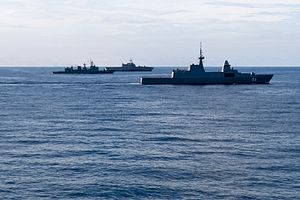Last week, the navies of the United States, Singapore, and Thailand conducted a military exercise in the South China Sea. The engagement was yet another manifestation of ongoing U.S. attempts to multilateralize existing drills with Asian states in the face of rising security challenges in the region.
As I have noted before, the United States has a series of exercises that it does with Asian nations, from the Cooperation Afloat Readiness and Training (CARAT) exercise that now includes nine South and Southeast Asian countries along with a naval engagement activity with Vietnam, to the smaller Southeast Asia Cooperation and Training (SEACAT) exercise with six nations.
But over the past few years, U.S. military planners have been signaling their intention to further multilateralize such exercises over the next few years. Back in October 2015, Rear Admiral Charlie Williams, the commander of the U.S. Seventh Fleet’s Task Force 73, which helps plan, organize, and support the execution of key U.S.-led maritime exercises in the Asia-Pacific, told me in an interview that the United States was looking to expand its naval exercises centered around themes that were of common interest (See: “Interview: The Future of US Military Exercises in the Asia-Pacific”).
That intention has slowly been translating into reality. Indeed, as I noted while attending the Shangri-La Dialogue last June in Singapore, the United States used the time in between the bilateral phases of the CARAT exercises it did with Malaysia and the Philippines to conduct a multilateral training activity in the Sulu Sea (See: “The Other Sea That Dominated Asia’s Security Summit in 2016”).
Singapore and Thailand are also featuring in the growing multilateralization of these exercises. This is no surprise. Both have been in other trilateral engagements before, with a case in point being Cope Tiger, an annual multilateral aerial exercise most recently held in March this year. More generally, the two countries have a longer record of belonging to these exercises, which makes the level of their cooperation with the United States relatively more advanced. Singapore and Thailand are thus better candidates for more sophisticated engagements (although Thailand did see a temporary scaling down of exercises after a coup in 2014) (See: “Exclusive: Managing a US-Thailand Alliance Under Strain”). Within CARAT, for instance, both Thailand and Singapore were original participants when the exercise first began back in 1995.
Last week, we witnessed one manifestation of this growing multilateralization when the U.S., Singapore, and Thai navies completed a three-day multilateral iteration of the Cooperation Afloat Readiness and Training (CARAT) exercise in the South China Sea.
During the trilateral exercise, the ships’ crews completed what Task Force 73 described as “a robust schedule” including “a broad spectrum of naval competencies and maritime security training,” with activities such as divisional tactic maneuvers, visit, board, search-and-seizure training, joint flight operations, and communications drills.
Participating U.S. vessels included the Arleigh Burke-class guided-missile destroyer USS Sterett (DDG 104) and the littoral combat ship USS Coronado (LCS 4). As for Singapore and Thailand, the Republic of Singapore Navy (RSN) was represented by the Formidable-class frigate RSS Intrepid (FFS 69), while the Royal Thai Navy (RTN) was represented by the Naresuan frigate HTMS Naresuan (FFG-421).
The participating ships will also join the International Maritime Defense Exhibition (IMDEX) in Singapore, Asia’s largest maritime defense trade fair, which will take place from May 15 to May 18. This year’s IMDEX is being held in conjunction with the 50th anniversary of the RSN (RSN50), which has seen a whole range of commemorative activities being held in the city-state (See: “Foreign Warships to Join Singapore For First International Maritime Review”).
































